Mario (Japanese: マリオ Mario) is a video game character and the star of the Mario series. He is Nintendo's most successful character; his games have sold over 200 million units worldwide. This, and other key factors, has led him to become the defining video game character and Nintendo's mascot. Designed by Shigeru Miyamoto for the arcade video game Donkey Kong, Mario was initially known as Jumpman, though Nintendo felt that, in order for him to become successful, his name would have to be changed to something more approachable and memorable. His appearance in Donkey Kong alone granted him instant recognition, and his appearance in the Nintendo Entertainment System game Super Mario Bros. fueled what was to become the most successful video game series of all time.
Mario's games not only ensure an insurmountable level of quality, but they also guarantee to press the various genres his games are a part of forward, whether it be platformers, role-playing games or even racers. Donkey Kong gave way to the platforming genre, a plot and multiple levels, while Super Mario Bros. introduced over 40 million gamers to scrolling stages, various environments, and an incomparable physics engine. Super Mario World for the Super Nintendo Entertainment System gave Mario a steed to ride upon named Yoshi, graphical advancements that used the various powers of the console, and almost 100 level exits. Super Mario 64 is perhaps one of the biggest advancements in the series since the original game. Often called the most innovative title of all time, Super Mario 64 is one of the pioneering three dimensional video games and was the first with a camera that the player could control. Super Mario Sunshine for the Gamecube combined Mario's famous jumping abilities with the use of a powerful water gun mounted on Mario's back known as the FLUDD . Super Mario Galaxy on the Wii sent Mario soaring through space and incorporated a fantastic gravitational system. These examples are but a few reasons why Mario is so important to the industry.
Mario isn't devoted exclusively to video games. He's appeared in a variety of television shows and merchandise, comic books and even a feature film. Despite these additional products, the franchise shines best when left to the realm of video games.
Mario's attire consists of his signature red and blue clothes. His overalls are blue, while his undershirt and hat are red. On Mario's hat is a big red 'M'. His hat was originally added to his attire so that the developers wouldn't have to animate flowing hair on the NES, as doing so with such small sprites was not reasonable at the time. His overalls were included in order to show Mario's movements more fluidly, while his famed mustache is there because the developers at the time didn't want to draw something as small as a mouth. Ever since Mario's FUNdamentals, Mario has been voiced by Charles Martinet, who also does the voices of various other Mario characters such as Mario's brother Luigi, nemesis Wario, Waluigi, and others.
History and story
Beginnings
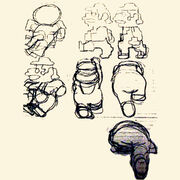
Concept art from Donkey Kong.
Mario was introduced in the arcade classic Donkey Kong. He was at first known simply as Jumpman, though Nintendo changed his name to Mario after Nintendo of America's landlord in 1981, Mario Segali. Initially he was just known as Mario in America, though the name would soon go into effect in Japan. In Donkey Kong, the player would traverse a series of construction site girders in order to save his girlfriend Pauline from Donkey Kong. The game was the first title with a developing plot and cutscenes. It introduced characters background and was the pioneering platforming game and was the first title with a "damsel in distress". The game saved Nintendo from an almost inevitable death that would've resulted had this game been a failure as their previous efforts had been. Shigeru Miyamoto, the creator of the game and its characters, had only just begun.
Naturally, Donkey Kong's success led to a sequel, titled Donkey Kong Jr. In this game, Mario became the villain and Donkey Kong was the ape in distress. Players took control of Donkey Kong's child Donkey Kong Jr. who was on a mission to save his father, which could be accomplished by finding various keys scattered across the level. This game showed that both Mario and Donkey Kong could both be considered protagonists and antagonists, and both can be considered good guys and bad guys. While Donkey Kong's villainous acts in the original game may seem to suggest that he's the true enemy, Miyamoto revealed that it was due to mistreatment by Mario that he acted in such a way. The game was expectedly successful, though not as much as its predecessor. One thing worth noting is that when all levels are completed, Mario is shown falling from a large height and landing on the steel girders that make up a majority of the levels. The significance of this is that after Mario's fall, he is shown laying on the ground with a halo above his head, the means of depicting death in the first Donkey Kong game. Whether this makes the game non-canon or not is debatable.
In 1983, Mario joined his brother, Luigi, as the newly christened Mario Bros. for arcades. Luigi was nearly identical to Mario initially save for a few alterations in clothes, though they even shared similar tastes in that department as well. In the game, which was multiplayer enabled, the players would take control of Mario and rid the sewers of pesky enemies by going directly under the platform they're stationed on and jumping underneath it, which will cause them to tumble over (depending on the enemy, you may need to perform more acts), afterwards, your goal is to go over to the enemy and kick it away. While the game's biggest introduction was undeniably Luigi, it also featured turtles for the first time, whose involvement in the Mario universe would be more expanded as more games were released. Oddly, Nintendo left Mario out of Donkey Kong 3, which became the least successful game in the series. This perhaps proved to Nintendo that, despite Donkey Kong being in the title, Mario was the true hero of the series. Despite all three of the games Mario's starred in being incredibly successful, his career was about to make a big bang with the onslaught of the Famicom.
Enter the Famicom
Atari, the industry's biggest name, was not only financially stable but was raking in millions of dollars annually with their home consoles, first party titles and strong third party support. They even managed to get licenses to release Nintendo's popular arcade games on their consoles. Then an event occurred that none foresaw. They failed. The infamous video game crash of 1983 had started. Multiple key events brought this on,the most significant one being the rise of home computers, but they all ultimately led to the downfall of not only Atari, but the entire industry as a whole. What possessed Nintendo to release a console after this crash had occurred is anyone's guess, but they did. It was called the Famicom, and a game starring the carpenter turned plumber from Nintendo's past arcade titles would not only become one of the most successful games of all time, but would be credited for saving video games. Nintendo releasing the Famicom in Japan wasn't too much of a shock, as entering the business didn't really ensure a failure in that country. But what shocked everyone is when Nintendo announced it for America under the name of the Nintendo Entertainment System, or NES for short. Nintendo would release the NES two years after the Famicom, but in order to get people's attention, they would need the help of an industry saver. Surprisingly, that hero wasn't Mario, but rather a robot named R.O.B., which caused retailers to think that this wasn't a video game, but rather a toy. They were convinced, but upon being released it wasn't R.O.B. that brought in droves of people, but rather a game called Super Mario Bros.
In Super Mario Bros., an evil character named Bowser, the leader of the Koopa, used his black magic to transform all of the citizens of the Mushroom Kingdom into inanimate objects. He kidnapped Princess Peach and took her to his most heavily guarded castle. Mario and Luigi heard of the news and set off to save her and everyone else. They eventually managed to save the princess after defeating Bowser and sending him into a pit where he was submerged in lava. The game ended with Princess Peach thanking either Mario or Luigi, telling them that a second quest is available.
The story of Super Mario Bros. isn't what captivated people, though. Rather, it was the engaging gameplay, the expansive levels, and the sense of wonderment at every turn. Players didn't know what to expect, and would constantly find new abilities that Mario could perform, whether it be growing larger by gobbling a Super Mushroom, being able to launch fireballs with a Fire Flower, or becoming invincible with a Starman. The physics were also impressive. Mario would jump farther when running, could get under tight spaces by ducking and running at the same time, and could even be maneuvered when in mid air. In total Super Mario Bros. sold over 40 million copies worldwide, accounting for nearly one fourth of all the Mario games. It should be noted, however, that this was due to the game being packed in with every NES for some time. It should also be noted that as of 2009, Wii Sports has surpassed Super Mario Bros. in sales.
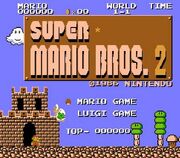
As evident above, the Japanese exclusive sequel resembled the original in many ways.
Super Mario Bros. was certainly not the last Mario game on the NES. The next entry wouldn't actually be released in America or Europe until the release of Super Mario All-Stars years later in 1993. This game, titled in Japan as Super Mario Bros. 2, was almost identicle to the original, though was much harder. Its difficulty was the reason why Nintendo never released it to Western audiences, who would instead be offered the Western version of Super Mario Bros. 2, which was in actuality a remake of Doki Doki Panic, a Japanese Famicom video game. The characters and some of the themes were replaced with those from the Mario universe. The game took place in Mario's dream, and in it he imagines that he opens a door to a world called Subcon. He later finds that this kingdom has been brought into battle with a king named Wart. When he wakes up, he tells Princess Peach, Toad, and Luigi of what had just happened while out on a picnic, and finds a cave strikingly similar to the one from his dream. He then enters the cave and finds that the world is real, and Mario and his friends vow to save the world and take down Wart. They do so, and the game ends. This game was later released in Japan as Super Mario USA, referring to the fact that it is the American version of Super Mario Bros. 2. The game in Japan clearly states that it is a remake of Doki Doki Panic.
After the success of both titles, a movie named The Wizard was released by Universal Studios, who had previously sued Nintendo due to copyright infringement based on the similarities between King Kong and Donkey Kong, but ultimately lost. The movie is best described as an hour and a half advertisement of Nintendo and Universal Studios' theme parks. But, it was also the debut of Mario's next hit video game, Super Mario Bros. 3, the last of the series for the Nintendo Entertainment System. The movie wasn't successful critically or financially, though the game it revealed was. In fact, it is among the most successful standalone titles of all time (or rather a game not packaged with a console or an accessory). Many argue the game to be the best that the series has to offer, though fans are split on the decision. The game took the basic concept of the original Super Mario Bros., and expanded upon it in marvelous ways. The game, for the first time in the series, featured a powerup that would give Mario the ability to fly. The power up, which made Mario resemble a raccoon, would let him access areas and would cause the screen to scroll diagonally, which wasn't present in games before it. There were a variety of other powerups as well such as the Hammer Suit, the Tanooki Suit, the Frog Suit, and some from the original Super Mario Bros. In the game, Bowser was back to his old tricks and turned eight kings around the world into animals and sent his seven children to take their place. Mario had to go through each kingdom, thwart the Koopa Kid, and eventually take on Bowser himself when he would send him down yet another pit, this time one that was supposedly bottomless. Inevitably, however, Bowser would be back, though next time it would be in a different era of consoles.
The SNES and the Game Boy
Sega, a new competitor, had released a console and proclaimed to the American audience that "[they] do what Nintendon't". A powerful marketing campaign advertising an equally powerful console that out shined the NES in every way imaginable. It was time to leave the NES behind and release a new console, the Super Nintendo Entertainment System, or SNES for short. In Japan it was appropriately titled the Super Famicom. Released a year before the SNES was the Game Boy, a handheld console and the first one with interchangeable cartridges. Among the launch games were Super Mario Land (a Mario platformer), and the more important Tetris. In Super Mario Land, Mario would have to save Princess Daisy from the evil Tatanga. Super Mario Land wasn't actually headed by Shigeru Miyamoto, but rather his mentor Gunpei Yokoi, who created the Game Boy and various other products and software. While the Game Boy and Super Mario Land were very successful, Nintendo had to focus on releasing the Super Famicom a year later in Japan, and in order to make a splash they'd have to release a new Mario game alongside it. So, in order to do this, they brought back the all-star team that made the previous console Mario games while Gunpei Yokoi and his team focused on the handheld titles. Shigeru Miyamoto and Takashi Tezuka, the creators of the NES Mario games, headed the new Mario title with Tezuka at the helm. They were going to abandon the Bros. name and introduce Mario and crew to the world of the SNES, which offered new powers unavailable previously. The end result was none other than Super Mario World.
Super Mario World, like Super Mario Bros., was packaged with the Super Famicom/SNES. It included the basic concepts from the previous games, and expanded on some such as the map from Super Mario Bros. 3. It brought back the Koopa Kids, featured exciting, vibrant graphics, an overhauled game engine and of course the introduction of a particular dinosaur.
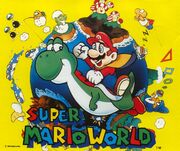
Super Mario World introduced Yoshi.
Yoshi, Mario's new steed in the game, was planned to be used in an NES title though the console couldn't handle the requirements it took in order to make it possible. So, they waited for the new console to be released in order to include him. Mario would find Yoshies in eggs, and upon hatching he could ride on top of them. Yoshi will use his elongated tongue to gobble up enemies and items, and has his own set of powerups such as the ability to fly, blow fire, and stomp on the ground with tremendous force. There were four colors of Yoshi in the game (green, blue, red, yellow), each with their own abilities. Super Mario World is also known for introducing Ghost Houses.
While Nintendo was releasing Super Mario World, Sega had a game of their own that would compete heavily with the title. That game was Sonic the Hedgehog, a game that starred Sonic ironically capable of running at speeds well over that of any other game character. Sonic would become Sega's mascot, and the two companies would compete for over ten years. A bitter relationship would eventually come to an end, however, when Sega quit the console business and teamed up with the three companies they once competed with. Sonic and Mario eventually would star in many games together such as the Mario & Sonic at the Olympic Games series and Super Smash Bros. Brawl.
The success of Super Mario World drove Nintendo to create various spin-off titles. They had done so similarly on the NES with games such as Dr. Mario, though the SNES brought on even more classics such as Super Mario Kart and Mario Paint. Super Mario Kart starred eight classic Mario characters including Mario himself. It introduced the world to the "kart" genre, and would eventually be followed by many sequels. Today the Mario Kart series is more lucrative than the Super Mario series on consoles.
Meanwhile back on the Game Boy, the developers who made the original Super Mario Land were hard at work on a sequel. The game, titled Super Mario Land 2: 6 Golden Coins, was significant for introducing the last of the major Mario characters. His name was Wario and he was initially considered the evil counterpart to Mario, a sort of doppelganger who in the game took ahold of Mario's Castle and made it his own. Astonishingly he became so popular in that game that subsequent titles on the Game Boy dropped Mario altogether and starred Wario. He earned his own series that was completely separate to that of Mario's, and went on to become less of a villain and more of a greedy character with a need for cash, and would do anything to come in possession of it, whether it be doing something evil or doing something heroic.
In 1995 Shigeru Miyamoto and Takashi Tezuka were tasked with creating yet another Mario game, though their choice in characters that would star in the game and when it would take place might have surprised many when it was first announced. The game, titled Super Mario World 2: Yoshi's Island, revealed the origins of Mario and his brother Luigi. In the game, a stork was carrying Baby Mario and Baby Luigi to their parents when Baby Bowser's mentor Kamek foresaw the future and found that the two brothers would cause nothing but trouble for his master. So, he scurried off and attacked the stork, kidnapped Luigi, and let Mario fall down to the ocean. His expectations that Mario would submerged in water were false, as he fell directly above an island named Yoshi's Island. A Yoshi who was taking a walk saw Mario coming down and rescued him just in time. Sensing that Mario was searching from someone, he used the map that the stork was using that fell down with Mario in order to reunite the two brothers with the help of the various Yoshies on the island. Super Mario World 2: Yoshi's Island was initially planned to be a 3D game in a similar vein to Donkey Kong Country. Shigeru Miyamoto, however, wasn't too fond of that title and deliberately went the exact opposite way from what Nintendo wanted him to do and had the game's art style altered completely to resemble a drawing made with crayons and pastels. The game was successful, though didn't reach the amount of sales that Nintendo had hoped. Nevertheless, it made enough money to warrant various sequels such as Yoshi's Story on the Nintendo 64, Yoshi's Touch & Go, and Yoshi's Island DS (both latter games for the Nintendo DS), among others. In Yoshi's Island DS Yoshi would carry around various different Mario characters such as Baby Donkey Kong, Baby Peach, Baby Wario, and others.
In 1996, Nintendo and Final Fantasy developer Square created the first ever Mario RPG titled Super Mario RPG: Legend of the Seven Stars for the SNES. The game was significant not only because it was the first Mario RPG, but also because it was the last Square developed game for Nintendo until 2003. The game featured a pseudo three dimensional Mario and crew, and featured various new characters like Geno and Mallow who, despite being beloved by fans, never made anymore prominent appearances in games. In Super Mario RPG, Mario would team up with a variety of characters, including Bowser himself, and would take down the evil Smithy who threatened to take over the Mushroom Kingdom. The game can be considered the first Mario game to contain an epic storyline, which comes to no surprise considering that it was developed by the people who made Final Fantasy.
A pioneer of 3D graphics in games
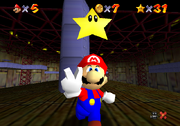
Super Mario 64 was the leading three dimensional game when it was released.
The same year Yoshi's Island was released, Nintendo had to come with terms that a new rival was on the rise in the form of a previous alliance. Sony had plans to release the PlayStation on their own when initially they had planned to do so with Nintendo. Things didn't go the way they were originally supposed to, however, and the two separated and planned to release their own consoles without the assistance of one another. A year after the PlayStation was released, Nintendo went along and released the Nintendo 64. Featuring the first ever modern day joystick and the ability to render 3D graphics, Nintendo would inevitably take advantage of these two features when creating their next Mario game. And so they did. Nintendo announced Super Mario 64 and revealed astonishing 3D graphics that showed a newly rendered Mario jumping around in environments that were never thought possible previously. The game featured the first camera that the player had full control over, and featured unique star collecting system where players could gain access to new areas by finding stars scattered across the various stages. In the game Bowser once again took Princess Peach and locked her up at the top of her castle. Mario gradually gained access to new areas and eventually conquered Bowser, thus saving Princess Peach. To date, Super Mario 64 is among the highest rated games of all time. It was also the first mainstream Mario game to feature Charles Martinet as the voice. He had previously done Mario in Mario's FUNdamentals for the personal computer, though he managed to get the job for the game's first 3D outing and all subsequent games.
Various other Mario games were released on the Nintendo 64 that pushed the boundaries of what the console could do. Mario Kart 64 was the sequel to Super Mario Kart and featured new characters such as Donkey Kong and Wario. Hudson Soft created the Mario Party series in 1999 while Nintendo started to experiment with Mario sports titles with games like Mario Tennis and Mario Golf by Camelot. Intelligent Systems took what Square did with Super Mario RPG and pushed it farther with the release of Paper Mario, a role-playing game that featured an engaging and humorous story, unusual for a Mario game but nonetheless very welcome. HAL Laboratory even got involved and released Super Smash Bros. which featured twelve different Nintendo characters including Mario himself fighting with each other.
The GameCube and the Game Boy Advance
Following the Nintendo 64, which was less successful than expected, Nintendo had plans to release the console's successor titled the GameCube. It featured enhanced graphics and more power in addition to a much improved controller. Along with the announcement came the debut of what was thought to be the next Mario game.
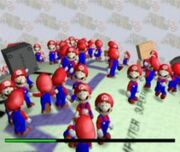
The Mario 128 tech demo.
Titled Mario 128, it was in actuality just a tech demo directed by Yoshiaki Koizumi (who would later direct Super Mario Sunshine and Super Mario Galaxy). In it, 128 Marios would fall from the sky on a platform that could be altered and morphed in ways that couldn't be done on the Nintendo 64 before it. Upon the GameCube's release, however, there wasn't a Mario game in sight. Instead, Nintendo opted to release Luigi's Mansion instead. In it, Luigi would become the hero and save Mario from a haunted mansion. Despite giving Luigi his first big solo adventure, Nintendo still had plans to release a new Mario game, it being titled Super Mario Sunshine. In Super Mario Sunshine, Mario, Princess Peach, and Peach's steward Toadsworth are going on a vacation to Isle Delfino. Upon arrival Mario is framed by an unknown culprit and is forced to clean up the goop that he supposedly spread across the island. He does so with the help of F.L.U.D.D., a unique water spraying device made by Professor E. Gadd. On the adventure Mario eventually manages to reveal who truly is behind all the mess, and it happens to be none other than Bowser and his son Bowser Jr. The game wasn't as revolutionary as Super Mario 64, and Mario's relying on F.L.U.D.D. too much coupled with not much level diversity caused some fans to question if Mario had lost his magic. Still, despite these shortcomings, the game was still among the highest rated platforming titles of that generation.
A little while before the GameCube was released Nintendo actually sent out the Game Boy Advance to retail. Other than a remake of Super Mario Bros. 2 titled Super Mario Advance and a new Mario Kart game called Mario Kart Super Circuit, the handheld didn't deliver too many Mario titles in the launch window. As time progressed, however, so did the availability of Mario games on the console. Camelot would release new entries in their sports series, Fuse Games would make Mario Pinball Land, Nintendo Software Technology would develop Mario vs. Donkey Kong, and perhaps most importantly of all, AlphaDream would create Mario & Luigi: Superstar Saga. A new Mario RPG, this was also the first one where Luigi was a playable character alongside Mario. It started a new franchise and would spawn various successful sequels. Remakes of Super Mario Bors. (in the form of NES Classics), Super Mario Bros. 3, Super Mario World, and Super Mario World 2: Yoshi's Island were all also released, among other titles.
Intelligent Systems released a sequel to Paper Mario for the GameCube called Paper Mario: The Thousand-Year Door. The game, perhaps due to not being released at the very end of the console's life, was more successful than the original game and featured a more interesting story involving a mystery behind a door that would open after one thousand years of being shut. There were a variety of other Mario games released on the GameCube as well such as Mario Kart: Double Dash!!, Mario Power Tennis, Mario Golf: Toadstool Tour, four Mario Party games, and others too.
Bridging the gap
It was time for Nintendo to rethink their strategy. The GameCube had done even more poorly than the Nintendo 64, and despite the fact that the Game Boy Advance had done phenomenally they still had to think of a new plan in order to bring back fans and new people. They had to bridge the gap between those who play games and those who don't. And the result of this thinking came the Nintendo DS. The Nintendo DS is perhaps Nintendo's most risky invention ever. It was a handheld that featured two screens, the bottom one a touch screen. It was unclear exactly how Nintendo planned to find the potential of this, though they, among hundreds of other developers, managed to do just that when the DS was released. Super Mario 64 DS was the console's primary launch title, and was, as the name suggests, a remake of Super Mario 64 that featured new playable characters such as Yoshi, Luigi and Wario. The game did fantastic, but there was another game that was set to take the market by storm.
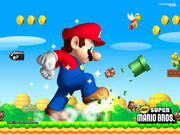
New Super Mario Bros. made Mario bigger than ever
That game was New Super Mario Bros., which was a new entry in the Super Mario Bros. series. Released in 2006, it has managed to outsell Super Mario Bros. 3 and is considered one of the most successful games of all time. The game went back to the series' roots and featured traditional and easy to adapt to gameplay with a few new features such as 2.5D graphics and new powerups including the Mega Mushroom, the Mini Mushroom, and the Blue Shell. Not only did the game do well in the market, it also faired extremely well with critics and fans.
The handheld market wasn't what Nintendo was too worried about, however. It was the consoles where they were failing, and was there where they really needed to take risks in hopes of reaching to new customers. So, at the Tokyo Game Show in 2005, Nintendo revealed the controller for their upcoming console (then known as the Revolution). It resembled a television remote and could be held with one hand. It featured an extension that could connect to the bottom of the remote via a cord that could be held in the other hand, though it could be detached if the game you were playing didn't require it. In April of 2006 Nintendo announced the name of their new console, which caused an outcry among Nintendo fans. The name was Wii, and the name change, while initially bashed, could very well be a defining reason as to why the console became so successful. Upon having a name change, not only did video game blogs and websites report on it, though national news stations on television did so. Millions of people were revealed the name because of a name change. Coupled with the unique and strange controller, the Wii was the console that everyone had their eye on, and on almost everyone's mind was how the new Mario game would take advantage of the Wii's abilities. Like the GameCube before it, a Mario game wasn't released at launch. In fact, no game featuring a Mario character was. The next year Intelligent Systems released Super Paper Mario, a sidescrolling role-playing game that gave the player the ability to switch between a 2D and a 3D perspective. It featured countless villains such as Count Bleck and had the player controlling characters Mario, Princess Peach, Bowser, and Luigi. The game was successful, but it wasn't the new Mario platformer that everyone eagerly awaited. They would have to wait half a year after Super Paper Mario in order to play it.
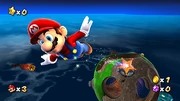
Mario soaring through space in Super Mario Galaxy.
Super Mario Galaxy was revealed at E3 in 2006, and wouldn't be released until a year and a half later in November of 2007, around the first year anniversary of the Wii. The game was developed by an unusual source. Instead of being developed within Nintendo's Kyoto headquarters, Nintendo EAD Tokyo, hundreds of miles away, took on the task. They had only previously worked on Donkey Kong Jungle Beat as a team, so it was surprising that they would be given the rights to such an important franchise. Yoshiaki Koizumi, the director of Super Mario Sunshine, took on the role of director once again for this title. In it, Mario would soar through space, jump from planet to planet, and save Princess Peach once again by going millions of miles away from home. The game incorporated a unique gravitational system that would let Mario go underneath planets and would even let him orbit smaller ones when he executed a long jump. Unless there was a black hole beneath the planets, Mario could go everywhere he wanted, and both players and critics alike loved it. Upon being released, Mario was deemed the highest rated game of all time by GameRankings.com, who collects various reviews from top critics and decides on an average grade. It eventually was lowered to number 2, though in a world with tens of thousands of video games available, this feat is nothing short of astounding.
At E3 in 2009, Cammie Dunaway of Nintendo announced two Mario platformers for the Wii including New Super Mario Bros. Wii and Super Mario Galaxy 2. This would make the Wii the first console since the Nintendo Entertainment System to have three main Mario games, and the first console since the SNES to have a direct sequel of a game released on the same console (that game being Super Mario Galaxy 2). New Super Mario Bros. Wii is both a single and multiplayer experience. In the multiplayer game, players take control of Mario, Luigi, a blue Toad and a yellow Toad. The game is both a cooperative and competitive experience and includes various new powerups and the return of Yoshi as a sidekick. In Super Mario Galaxy 2, the first sequel to a 3D Mario game, the plumber soars through space once again and is joined by Yoshi (like in New Super Mario Bros. Wii).
Spin-offs
Mario and crew have starred in various spin-off titles ever since their initial appearance. Spin-off games include the likes of Mario Kart titles, sports game, the Mario Party series, and tons of other games too.
- Dr. Mario series: Starting with the NES release of Dr. Mario Nintendo started to release various puzzle games that had Mario destroying viruses with pills of the same color as the virus. The games were so popular that they created a multitude of sequels such as Dr. Mario 64, Dr. Mario Online Rx, and Dr. Mario Express, among many others.
- Mario Paint: Released on the SNES, this game had the player using the SNES Mouse to create pieces of art in a similar fashion to how they would draw in Microsoft Paint. The game featured many Mario related themes and even had a music composer and a minigame where you could squash bugs with a fly swatter.
- Mario Artist series: These games were released exclusively in Japan for the Nintendo 64DD and were the successors to Mario Paint. The games released through the Mario Artist series include Mario Artist: Paint Studio, Mario Artist: Communication Kit, Mario Artist: Talent Studio, and Mario Artist: Polygon Studio. More were planned but ended up being canceled.
- Mario Kart series: Of course, Mario has appeared as the main character in every Mario Kart game hence the name. The first in the series, Super Mario Kart, is considered the first game in the Kart genre. Then he went on to play a major role in Mario Kart 64, Mario Kart Super Circuit, Mario Kart: Double Dash!!, Mario Kart DS, Mario Kart Arcade GP, Mario Kart Arcade GP 2, and Mario Kart Wii. His exclusive kart in Mario Kart: Double Dash was the Red Fire, while his exclusive karts in in Mario Kart DS were the B Dasher, the Standard MR, and the Shooting Star. His weight is always medium.
- Mario RPG series: So far various games have been released that are role-playing games. Square started the series with Super Mario RPG: Legend of the Seven Stars on the SNES, though subsequently Intelligent Systems made the Paper Mario series and AlphaDream the Mario & Luigi series. The games are discussed in greater detail in the history section above.
- Mario Party series: Released in 1999 for the Nintendo 64, Mario Party became so successful that Hudson Soft and Nintendo released tons of sequels for all of Nintendo's consoles and handhelds after the Nintendo 64. So far there have been eight console iterations, three handheld games (including Mario Party-e), and even an arcade title too. The games started the popular party genre. Mario is a playable character in the game, though his statistics are similar to everyone's in the game.
- Mario sports: Mario sports games have been around mainly since the Nintendo 64's release of Mario Tennis. The game was so popular that Nintendo decided to publish many more Mario sports games such as Mario Golf, Super Mario Strikers, Mario Superstar Baseball, Mario Hoops: 3-on-3, Mario Strikers Charged, and others. It should also be noted that Mario, along with Luigi and Princess Peach, was a playable character in EA created titles SSX on Tour and NBA Street V3. It was thought that EA would include the three characters in SSX Blur, though once the game was released, the rumor was put down.
- Mario & Sonic at the Olympic Games: Mario and Sonic were brutal rivals in the 90s, when SEGA was still making consoles. When the Dreamcast failed, a doorway between them opened up. Fans of the two have long since wished to see the two compete in the same game. The two finally have with the release of Mario & Sonic at the Olympic Games and Mario & Sonic at the Olympic Winter Games for the Wii and Nintendo DS. Mario and Sonic also appeared side by side in Super Smash Bros. Brawl.
- Others: There have been many more Mario games as well beyond the ones listed above. Konami teamed up with Nintendo to release Dance Dance Revolution: Mario Mix on the GameCube. Nintendo Software Technology made Mario vs. Donkey Kong and its sequel, Mario vs. Donkey Kong 2: March of the Minis on the Game Boy Advance and Nintendo DS, respectively. Fuse Games created Mario Pinball Land for the Game Boy Advance, which had Mario rolled up in a ball.
Outside appearances and cameos
Mario has been featured in various non-Mario games, most of which are games published by Nintendo, though some third party titles as well. He has appeared as a playable character in all three Super Smash Bros. games.
Super Smash Bros. series
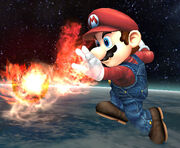
Mario tossing a fireball in Brawl.
Mario is a regular in all of the Super Smash Bros. video games. He has appeared in every game since the original on the Nintendo 64. He is a balanced character who is naturally great for beginners. His brother Luigi is considered a "clone" of Mario, having similar attacks. The newer Super Smash Bros. games, however, are gradually ridding of the similarities. Dr. Mario from Super Smash Bros. Melee was an outright clone with different clothes and attacks that were slightly more or less potent.
Mario's special moves consists of Fireballs that can be launched with the B button. The fireballs will bounce on the ground and rise in the air shortly before going back down in a similar fashion to how they performed in Super Mario Bros. HIs up B move, Super Jump Punch, is Mario's recovery move that'll send him punching upwards. In Super Smash Bros. and Super Smash Bros. Melee, Mario's down B move is Mario Tornado, which will cause the character to quickly spin, though this move was omitted as a special move in Super Smash Bros. Brawl and was replaced by F.L.U.D.D. (Mario Tornado was however made into a down A arial move). In Brawl, Mario's Final Smash is Mario Finale, which will cause him to launch two huge fireballs from his hand that span almost the entire stage.
Cameos
Mario has probably appeared in more games as a cameo than any other video game character in history. Below are some of his more notable appearances.
- 1080° Avalanche: There is an ice sculpture that towers over the players in one of the stages. 8-bit Mario references can be found throughout the game.
- Animal Crossing series: There have been various references to Mario games in the many Animal Crossing titles. Mario trophies, classic NES games, 8-bit Mario items and Mario themed clothing are but a few of the things featured in the game that reference the character.
- Drill Dozer: One of Jill's alternate costumes is Mario's overalls.
- F-Zero series: The character Mr. EAD is a reference to Mario and there are plenty of other nods to the series in the character too.
- Kirby Super Star: Mario is in the audience of the Megaton Punch Contest. One of the objects that Kirby might turn into when he uses his stone ability is a Mario statue.
- Kirby Super Star Ultra: Mario is in the audience of the Spring Breeze sub-game in level 4 along with Luigi, Wario, Princess Peach, and Toads . One of the objects that Kirby might turn into when he uses his stone ability is a Mario statue.
- Metal Gear Solid: The Twin Snakes: A Mario doll can be found in Octacon's lab in the game, as can one of Yoshi. Super Mario Sunshine is referenced when you fight Psycho Mantis if the game is recorded in the player's GameCube memory card.
- Mike Tyson's Punch-Out!!, Punch-Out!! Featuring Mr. Dream and Tennis: Mario is present as the game's referee.
- Nintendogs: Mario's hat is one of the obtainable items in the game, as is an RC Mario Kart toy.
- Pinball: Mario holds up the girder in the bonus stage, and is even present on the game's boxart.
- Pilotwings 64: If you shoot George Washington's face on Mount Rushmore in the game, it will be replaced by Mario's head. If you shoot it again, Mario's face will crumble and be replaced by Warios. Cheeky, but wicked.
- The Legend of Zelda series: Mario has made more cameos in the Zelda series than any other franchise. In A Link to the Past a portrait of Mario could be found in one of the game's houses. In Ocarina of Time, the character Talon is based on Mario and a picture of the character appears in Zelda's courtyard. A mask that had Mario's face on it could be seen on the back of the Happy Mask Salesman in Majora's Mask.
- Wii Fit: Various Mario sprites can be found on jogging roads.
Legacy
Mario has been featured on various merchandising products. The list of things he's been on is nearly endless, and includes the likes of clothes, hats, watches, wristbands, cereal boxes, ice cream bars, PEZ dispensers, pop cans, candy bars, mints, books, keychains, game cases, lunchboxes, phone straps, plush toys, chairs, curtains, bed spreads, cookie cutters, ceiling fans, wallets, mugs, figurines, stationary, toys, back packs, pillows, calculators, ties, cookie jars, sponges, band-aids and even Happy Meal and Burger King toys. This is just a fraction of the large amount of products that Mario and gang have been featured on.
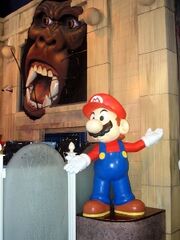
Mario at the Hollywood Wax Museum.
In 2003, the Hollywood Wax Museum announced that Mario would soon be featured at the museum. That year, Nintendo and the museum had a party to introduce the new wax model. They noted that Mario was the first ever video game character to be featured at the museum, and replaced Matrix actors Keanu Reeves and Carrie-Anne Moss in the museum's lobby. When they revealed the figure, Charles Martinet, the voice of Mario, said "They say you can't hold a candle to me, but now you really can't" (since the wax would melt).
They placed Mario to the right of the large King Kong. The model itself is five feet tall. Since then, one other video game character was introduced at the museum, that being Lara Croft.
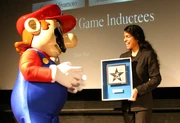
Mario accepting his Walk of Game award.
During the party, they had a contest to see who was the best Mario look-a-like, the winner got many Nintendo (mostly Mario) related prizes.
Recently, the museum put Nicolas Cage riding on a motorcycle right next to Mario.
Mario, along with Link and Sonic, were among the first characters to receive a place in the Walk of Game in 2005, video gaming's equivalent to movie's walk of fame. Oddly, the Walk of Game is owned solely by Sony, yet they have not presented an award to one of their video game characters/people/or games, but have rather been giving out awards to competing companies such as Nintendo (Mario, Link, Shigeru Miyamoto) and Microsoft (Halo: Combat Evolved). They have, however gave awards to many third party companies such as SEGA (Sonic the Hedgehog) and Square-Enix (Final Fantasy), among others.
In Nintendo Power V250, Mario was ranked the greatest video game protagonist of all time, and was also listed as having one of the best mustaches.
External links
- This article on Mario Wiki
- This article on Paper Mario Wiki
- This article on Mario Kart Racing Wiki
- Mario Wiki
| Characters in Mario | |
|---|---|
| Major characters | The Mario Bros. (Mario • Luigi) • Princess Peach • Toad • Yoshi • Bowser • Bowser Jr. • Rosalina • Waluigi • Princess Daisy • Toadette • Birdo • Wario • Donkey Kong • Diddy Kong |
| Secondary characters | Wanda • Pauline • Professor E. Gadd • Toadsworth • Captain Toad • Nabbit • Cappy |
| Enemies | Koopalings (Larry Koopa / Morton Koopa Jr. / Lemmy Koopa / Wendy O. Koopa / Iggy Koopa / Roy Koopa / Ludwig von Koopa) • Fawful • Kammy Koopa • Dimentio • Antasma • Kamek • King Boo • Petey Piranha • Tatanga • Wart • Foreman Spike • Koopa Troopa • Dry Bones • Goomba • Piranha Plant • Boo |
| Other media | Giuseppe |
